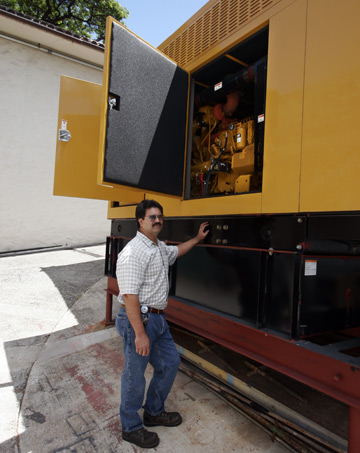HECO seeking power players
The utility will pay businesses to buy generators so HECO can pull the plug during peak use times
WHEN power outages swept southeast Oahu in early June, causing approximately 37,000 customers to lose electricity, among those prepared for such an event was the Honolulu Academy of Arts.
The museum had a generator in place to provide back-up juice -- mainly in case of a mass disaster, but also in less dire circumstances. As part of a program run by Hawaiian Electric Co. Inc., the academy uses its back-up source to lighten HECO's load during peak times.

DENNIS ODA / DODA@STARBULLETIN.COM
Richard Andrews, building engineer for the Honolulu Academy of Arts, shows the diesel engine that powers the academy's generator, which cost $170,000 including equipment and labor.
|
|
So when the electrical system came under stress, HECO cut power to the museum, the generator turned on and patrons -- as well as the museum's climate-sensitive collection of art -- never noticed the difference.
"It worked great," said Richard Andrews, building engineer for the academy, who oversees the program for the museum.
Andrews and other participants often speak of the program's altruistic dimension; how it lets them do their small part to help prevent an islandwide blackout. But the academy also gets cash. Every month, HECO pays the academy approximately $1,200, whether or not the power company has to pull the museum's plug.
That's enough over the program's five-year duration to offset more than a third of the new generator's cost, which totaled about $170,000 for equipment and labor.
The program is aimed at providing a modicum of breathing room for a system that's not expected to see much new capacity until 2009, when a new power plant is slated to come on line.
HECO isn't at risk of running out of electricity, said Peter Rosegg, a company spokesman. The outage in June, for instance, was prompted by a confluence of several unusual factors, rather than some chronic problem.
Still, HECO worries about its reserve supplies of electricity, which Rosegg said are "coursing downward." Given Oahu's isolation and inability to get extra power from some other place, which mainland companies can do, the company wants to have reserves in the 25-30 percent range, Rosegg said. They are now hovering at less than 20 percent.
So while it works to bring its new power plant on line, HECO is encouraging conservation. This includes going to businesses and asking if HECO can shut off their power during emergency situations, when businesses and homeowners are pushing the system by maxing out their air conditioners, computers and other energy-hungry hogs.
The company's goal is to sign up enough businesses to generate 21 megawatts of relief for HECO's system by 2009. It now has a little more than 4 megawatts enrolled.
The program is essentially a large-scale version of HECO's Energy Scout program, which lets HECO remotely shut down residential hot water heaters during peak times. Approximately one year old, the Energy Scout for Business program has just five commercial participants and one military one, although additional military installations are on the verge of signing up, said Paul Brencick, the project's program manager.
"We're going out to select business programs at this point," Brencick said. "But we do want to get word out that this program does exist."
Still, he cautioned, "If you have a small business, this will not work for you."
To qualify, businesses must have 200 kilowatts of power that HECO can shut off during prime time. HECO executives can't provide an example of a typical business that might use 200 kilowatts of power during the day. But businesses like warehouses and agricultural concerns are prime candidates, Brencick said. Condominium towers and hotels also could work, as long as they have back-up generators to run essential devices or some power-hungry element that wasn't essential to operations, like a big fountain or a noncritical set of elevators.
The Hale Koa Hotel is a case in point. During peak load times, HECO shuts off power to a parking garage and to a heat-pump hot water system, said Mark Rugenstein, the Hale Koa's chief engineer. That doesn't affect operations because the hotel can light the garage with a generator and heat water with a natural gas heater, Rugenstein said.
"Nobody's wedding gets put in the dark, or hot and sweaty," he said.
Meanwhile, the Hale Koa gets about $1,700 knocked off its power bill each month. Over the program's five-year duration, that adds up to more than $100,000.
The cost of all of this is passed on to ratepayers, and it's not insignificant. The program costs about $1 million annually, which includes incentives to participants, equipment, advertising and marketing, and HECO's direct labor to administer the program, Rosegg said.
Notwithstanding the savings, Rosegg said the program is about more than money.
"All of these people, from our perspective, are like heroes of the energy crunch," he said.

